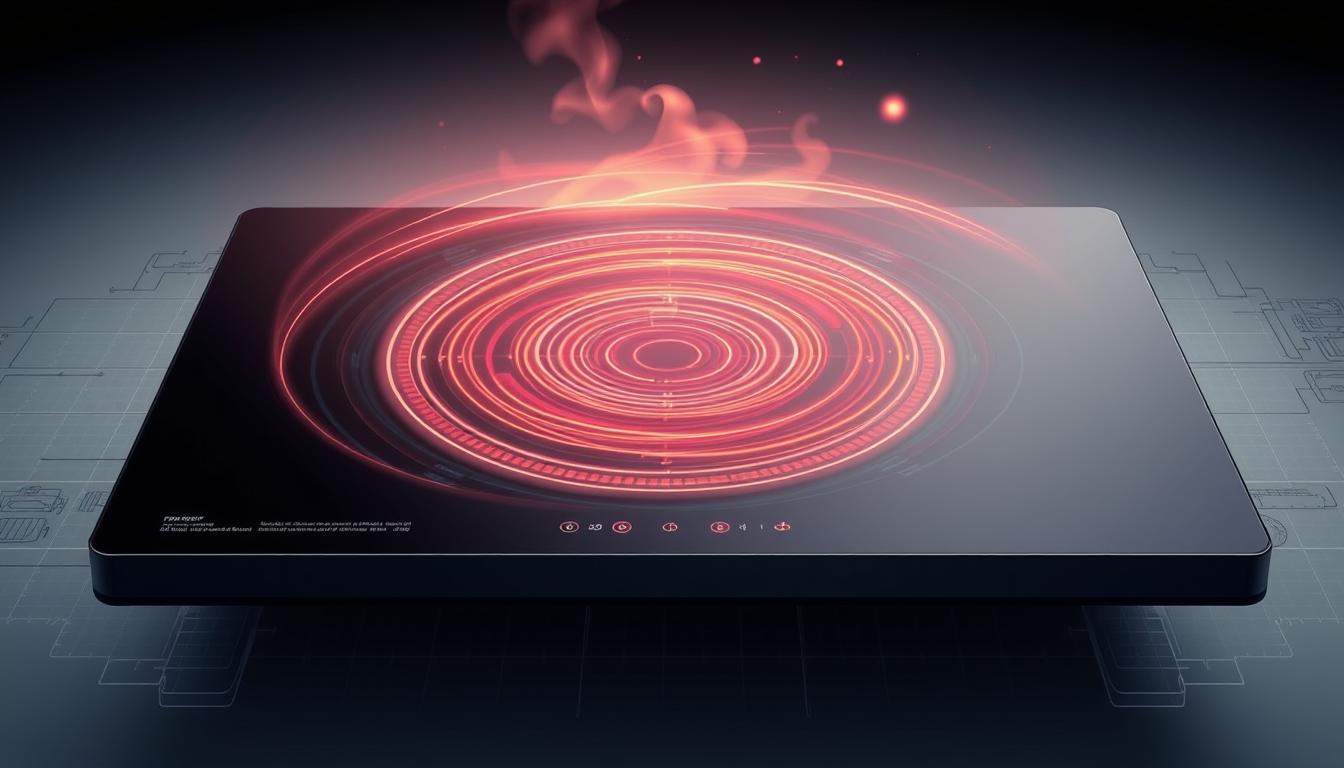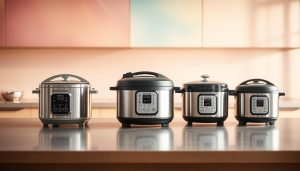Did you know your stove could waste up to 40% less energy than traditional methods? Unlike gas or electric ranges, modern culinary tools harness electromagnetic fields to heat pans instantly—without warming the air around them. This innovation isn’t science fiction; it’s the reality of today’s most efficient kitchens.
At the heart of this system lies copper coils beneath a smooth surface. When activated, they generate a magnetic field that interacts directly with ferromagnetic cookware. The result? Heat forms inside your pan, not on the burner. This process slashes cooking times by up to 50% compared to conventional methods.
Safety and precision define this approach. Since the surface stays cool, accidental burns become rare. Chefs gain instant control over temperatures, mimicking professional-grade responsiveness. Europe and Asia have embraced this method for decades, and now U.S. households are discovering its advantages.
Key Takeaways
- Electromagnetic fields heat cookware directly, bypassing surface heating
- Energy transfer occurs only with compatible pots and pans
- Up to 90% of energy converts directly to cooking heat
- Surface remains cool to the touch during operation
- Temperature adjustments happen faster than gas or electric
- Proven technology with decades of global use
Understanding the Basics of Induction Cooking
Your kitchen transforms into a precision lab when using electromagnetic energy. Beneath the sleek surface, copper coils hum with electricity, creating invisible magnetic fields. These fields directly energize compatible pans, bypassing traditional heating methods entirely.

Principles of Electromagnetic Energy
Electric currents race through coiled wires under the glass top. This action generates a magnetic field that penetrates cookware like a silent command. Your pan becomes the heat source itself, warming food faster than gas flames can react.
Only ferrous metals respond to this magnetic call. Iron-rich materials create friction at the atomic level when activated. This friction produces instant, controllable heat that stops the moment you switch off the power.
Overview of Compatible Cookware
Test your existing pans with a fridge magnet. If it clings firmly, you’ve got induction-ready gear. Cast iron works flawlessly, while stainless steel requires magnetic grades. For guaranteed results, explore induction-specific options designed for optimal energy transfer.
Thick-bottomed pans distribute heat evenly, preventing hot spots. Avoid materials like copper or aluminum unless they have magnetic bases. Remember: your cookware’s compatibility determines 90% of the system’s efficiency.
How Induction Cooktops Actually Work
Your stove’s hidden technology turns pots into instant heat sources. At its core lies a silent partnership between physics and engineering that transforms ordinary kitchenware into precision heating elements.

The Electromagnetic Heating Process
Activating your appliance sends electricity through coiled copper wires beneath the glass top. This creates a magnetic field that leaps upward, searching for ferrous metal. When your pan answers the call, swirling electrons generate friction within its base.
This atomic agitation produces immediate warmth in your cookware – not the burner. Your water boils faster because energy skips the middleman. Temperature changes happen in milliseconds, matching professional kitchen responsiveness.
The Role of the Cooking Surface and Coils
Specially engineered glass withstands intense thermal shifts while staying cool to touch. Beneath it, copper spirals form precise patterns that adapt to your pan’s shape. Multiple coil configurations ensure complete coverage for oval Dutch ovens and square griddles alike.
Thick ceramic surfaces protect the delicate electromagnetic components while providing scratch resistance. This design allows 85% of generated energy to reach your food, compared to 40% with gas burners.
Key Benefits of Induction Cooking
Modern kitchens demand tools that match today’s fast-paced lifestyles while conserving resources. Electromagnetic technology delivers performance advantages that transform meal preparation into an art of precision and practicality.

Rapid Heating and Temperature Precision
Water reaches boiling point twice as fast compared to gas ranges. Your pan becomes the heat source, eliminating warm-up delays. “The instant response lets chefs adjust temperatures with surgical accuracy,” notes a Michelin-starred kitchen manager.
Delicate tasks like tempering chocolate become foolproof. Dial down power levels, and the magnetic field adjusts immediately—no residual heat surprises. This responsiveness matches commercial-grade equipment used in top restaurants.
Energy Efficiency and Easy Cleanup
ENERGY STAR confirms these systems waste 67% less energy than gas alternatives. Since heat stays concentrated in cookware, your kitchen stays cooler. Spills won’t bake onto surfaces, reducing scrubbing time by half.
Advanced models feature smudge-resistant coatings that repel grease. A quick wipe restores the sleek surface after cooking. Combined with lower utility bills, these features make electromagnetic technology a smart long-term investment for busy households.
Comparing Induction with Gas and Electric Cooktops
Did you realize gas models leak methane even when idle? Stanford researchers found annual emissions from one stove equal driving 40 miles. This discovery reshapes how we evaluate kitchen safety and efficiency across heating methods.

Differences in Heat Generation
Gas units rely on open flames that warm pans and your kitchen air. Electric versions heat coils that glow red before transferring warmth through glass surfaces. Induction systems bypass these steps entirely—their magnetic fields create instant friction within cookware bases.
Traditional methods lose energy heating intermediate surfaces. Electromagnetic models direct 90% of power straight into food preparation. Your water boils faster because no energy escapes upward or sideways.
Efficiency and Safety Considerations
Gas flames waste 60% of energy heating empty airspace. Electric models lose 30% through radiant transfer delays. Induction’s targeted approach slashes utility bills while keeping surfaces cool enough to touch seconds after shutdown.
Stanford’s air quality tests revealed gas stoves emit formaldehyde levels exceeding EPA thresholds. Induction eliminates combustion risks—no carbon monoxide alarms needed. Automatic shutoff features prevent forgotten pans from overheating.
| Feature | Gas | Electric | Induction |
|---|---|---|---|
| Heat Source | Open flame | Glowing coils | Magnetic fields |
| Surface Temp | Extremely hot | Very hot | Warm |
| Energy Waste | 40-60% | 25-30% | 10-15% |
| Pollutants | Methane, CO | None | None |
Upgrading proves smarter than ever. While gas requires complex venting systems, induction needs only standard outlets. Your kitchen stays cooler, cleaner, and ready for precision tasks like melting chocolate without scorching.
Selecting the Right Cookware for Your Induction Cooktop
The right tools make all the difference in unlocking your stove’s full potential. Electromagnetic technology demands specific materials to create its magic, turning ordinary kitchen gear into precision heating elements.

Conducting the Magnet Test
Grab a refrigerator magnet for instant compatibility checks. If it clings securely to your pan’s base, you’ve got induction-ready equipment. This simple trick works because magnetic attraction indicates sufficient iron content for energy transfer.
Test multiple spots on curved or worn cookware. Some older pieces might work near edges but fail at the center. For best results, use flat-bottomed pans that make full contact with the cooking surface.
Choosing Durable and Compatible Materials
Cast iron stands out as the gold standard for electromagnetic cooking. Its dense structure maintains steady temperatures for perfect searing and simmering. Enamel-coated versions add versatility for acidic dishes without sacrificing magnetic properties.
When selecting stainless steel, check for “18/0” or “magnetic” labels. These grades contain enough iron to activate your stove’s coils. Avoid mixed-material pots with copper or aluminum cores unless they have magnetic base layers.
- Cast iron delivers unmatched heat retention for slow-cooked meals
- Magnetic stainless steel offers lightweight convenience
- Enameled pieces prevent metallic tastes in delicate sauces
- Certified induction-ready cookware eliminates compatibility concerns
Listen for faint humming with multi-ply pans – this normal vibration comes from layered metals reacting to magnetic fields. Focus on weight distribution rather than noise levels when assessing performance.
Installation and Safety Considerations
Proper setup transforms your kitchen into a high-efficiency zone. While electromagnetic models simplify cooking, they demand specific electrical configurations. Let’s explore what your home needs to harness this technology safely.
Understanding Electrical Requirements
Most full-size units require dedicated 240-volt circuits—similar to electric dryers. Portable countertop models often work with standard 120V outlets. Check your breaker panel before purchasing to avoid costly upgrades.
Upgrading from traditional electric ranges? You’ll likely reuse existing wiring. Converting from gas requires professional help: electricians install new circuits while plumbers cap old fuel lines. Always verify local building codes for compliance.
Maintenance and Safe Usage Practices
Though surfaces stay cooler, proper ventilation remains crucial. Range hoods effectively remove grease particles and cooking odors. Wipe spills immediately—dried residues can affect sensor performance.
The Institute of Electrical and Electronics Engineers confirms electromagnetic emissions stay within safe limits. Those with medical implants should consult doctors, though most users experience zero interference. Regular inspections ensure coils and glass surfaces remain damage-free.
Tips for Perfecting Your Induction Cooking Technique
Mastering electromagnetic cooking unlocks flavors you never knew existed. Unlike traditional methods, this approach rewards quick thinking and rapid adjustments. Your existing skills translate beautifully—with a few strategic tweaks.
Adapting Your Cooking Rhythm
Start by reducing preheating time. Cast iron skillets reach searing temps in 90 seconds flat. Lower heat settings often achieve better results—simmer sauces at power level 4 instead of 6.
Watch your food’s behavior, not the dial. Boiling water stops bubbling instantly when you lower temps. This immediate feedback lets you prevent overcooking delicate proteins or sauces.
Use your pot’s natural heat retention strategically. Turn off the burner 2 minutes early for perfect carryover cooking. Flat-bottomed pans maximize contact, ensuring even heating without constant stirring.
Keep a kettle nearby. Since induction boils water faster, you’ll save time prepping pasta or blanching veggies. Pair these techniques with precise temperature control to elevate everyday meals into culinary triumphs.



